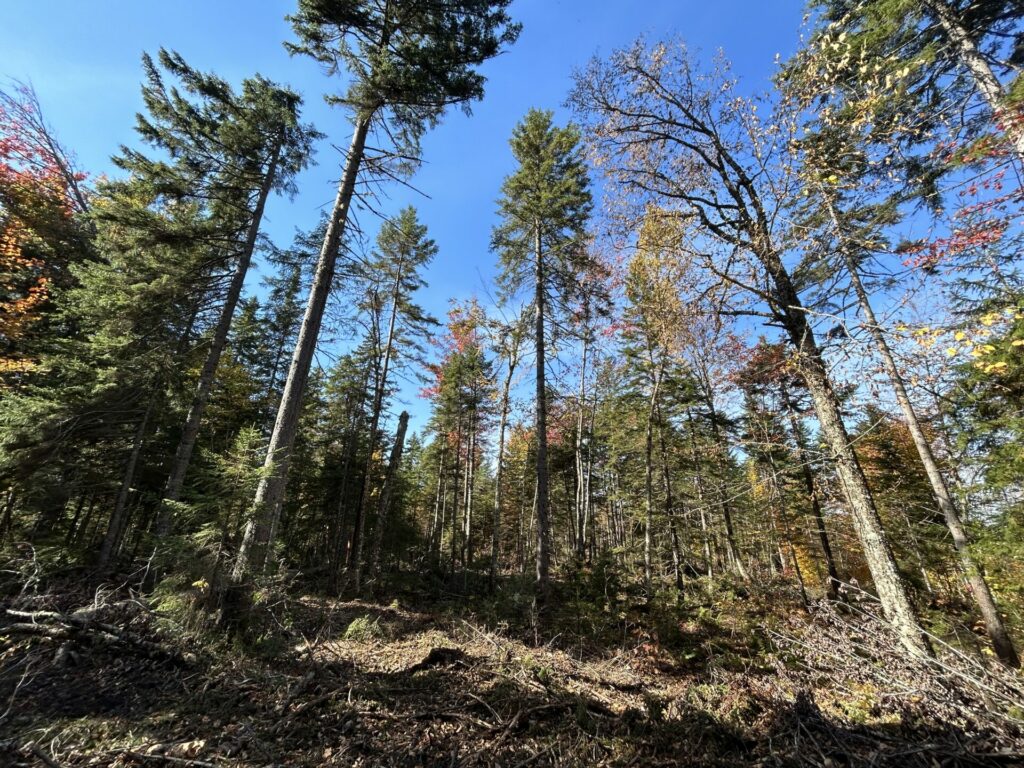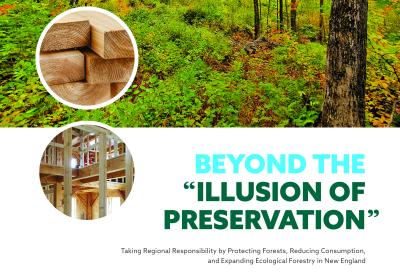A new report released today highlights the opportunity for New England to dramatically expand forest protections and sustainably meet the region’s wood product needs by reducing consumption and reorienting production.

The report calls on New England states to permanently protect roughly 70% of the region’s landscape—a significant increase from the 25% currently protected—while expanding sustainable forest management across two-thirds of New England’s forests. The report is by researchers from the University of Vermont (UVM), Harvard Forest, Conservation Science Partners, University of Massachusetts, and Brandeis University.
“New England is losing 30,000 acres of forest permanently to development each year,” says lead author Caitlin Littlefield, a Senior Scientist at Conservation Science Partners and graduate of UVM’s Rubenstein School of Environment and Natural Resources. “Even as the region touts a strong conservation ethic, we suffer from a considerable shortfall in production compared to our enormously high rates of consumption and our capacity for sustainable production. We need to dramatically accelerate protection of both wild forest and sustainably managed forests to take greater responsibility for our resource demands.”
The report finds that New England only produces three-quarters of the wood it consumes—and meets some of this shortfall with wood drawn from distant places with weaker environmental and social oversight. Even starker disparities exist in the region: 70% of the region’s production comes from Maine, while 70% of the region’s consumption occurs in Connecticut, Massachusetts, and Rhode Island. The report challenges these and other states in the region to boost production and reduce consumption of wood products.
The report makes three key recommendations to be achieved by 2060: 1) permanently protect 70% of New England’s landscape with at least 10% of the landscape in passively managed wild lands and 60% in actively managed forest; 2) reduce consumption of lumber and paper by 25% while meeting urgent housing needs and increasing recycling; 3) expand the practice of ecological forestry and shift production to more durable wood products.
“The forests of New England are crucial to supporting biodiversity and providing ecosystem services like clean air and water, carbon sequestration, and recreation opportunities. At the same time, wood remains an important renewable resource that we all rely upon and that can replace more carbon-intensive materials,” says Tony D’Amato, Professor and Director of UVM’s Forestry Program, a co-author on the report. “In addition, most of New England’s forests lie vulnerable to conversion to non-forest, leading to the loss of all forest benefits.”
The report, Beyond the “Illusion of Preservation,” revisits a 20-year-old study, The Illusion of Preservation, to quantify the imbalances between production and consumption in all New England states and provides a path forward for remedying that imbalance.
Expanding ecological forestry will require all forest ownerships to play a role: some corporate forests in northern New England would need to reorient toward practices that promote higher-value lumber in place of pulpwood, while the family-owned forests that predominate in southern and central New England would have to engage in active management on a scale not yet seen in the modern era.
“Every individual and family that stewards a forest has an important role to play—both in keeping our forests forested and in helping us meet our resource needs in a sustainable way, says University of Massachusetts Professor and State Extension Forester Paul Catanzaro, who co-directs the Family Forest Research Center and co-authored the report. “For too long, we’ve not acknowledged, let alone celebrated, our age-old reliance on and relationship with forests.”
Danielle Fitzko, Commissioner of the Vermont Department of Forests, Parks and Recreation commented on the report: “I applaud the authors’ visionary research, which underscores the need to safeguard our forests, curtail consumption, and expand ecological forestry. This forward-thinking approach to stewardship, exemplified in our management of state lands, is a model for all. Their study is an essential guide in our journey toward a future where forests thrive and our needs are met sustainably.”
According to the researchers, the goal of ecological forestry is to harvest wood products in ways that emulate natural patterns and dynamics of the forest and that sustain key values like habitat for a diversity of wildlife. The approach might not produce as much harvestable wood as rapidly as other practices like intensive plantations, but it does produce a steady output of long-lived, high-market value wood products, while also sustaining many other ecological and social benefits. The report calculates that, if ecological forestry were expanded to 20 million acres across all states in the region and the consumption reduction goal was achieved, the region could sustainably meet its wood needs.
The report will be released at the New England Society of American Foresters annual meeting, occurring in South Burlington, Vermont, from March 27-29. Littlefield will give the keynote presentation and co-authors Catanzaro and Brian Donahue of Brandeis University will facilitate a panel discussion on how we can achieve the three key steps of protecting forests, reducing consumption, and expanding ecological forestry across New England, all while pursuing urgent biodiversity and climate goals.
DOWNLOAD THE FULL REPORT HERE

